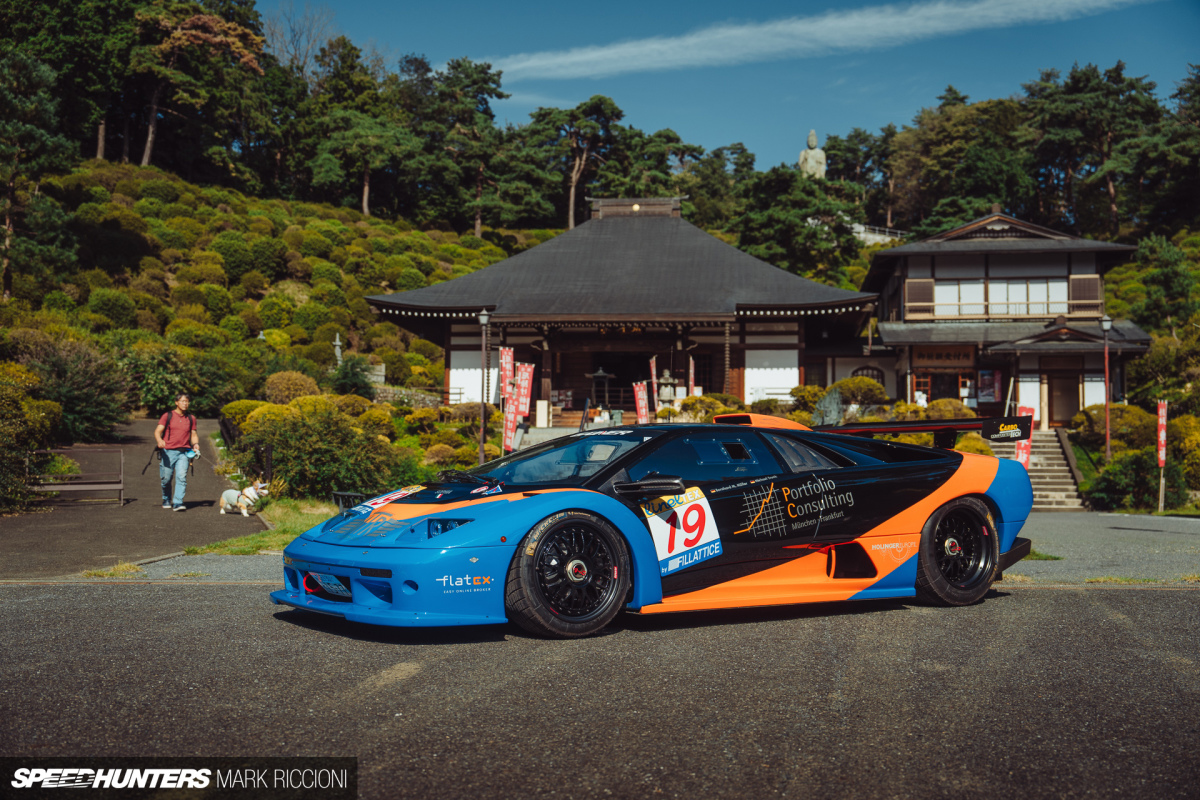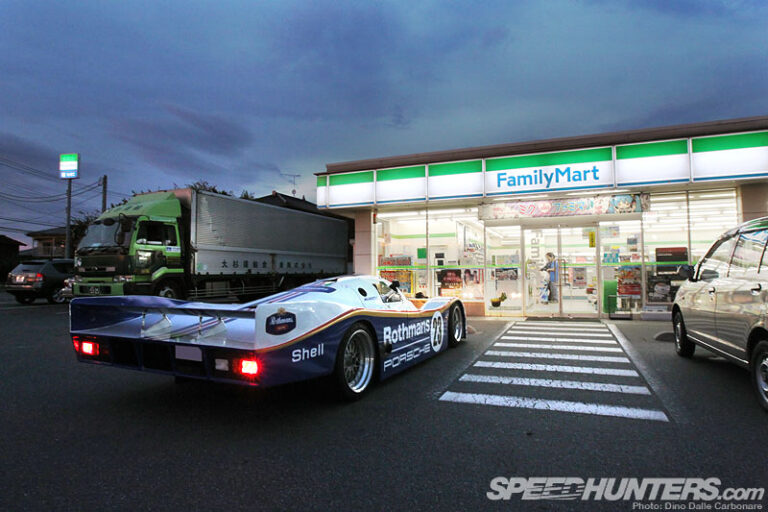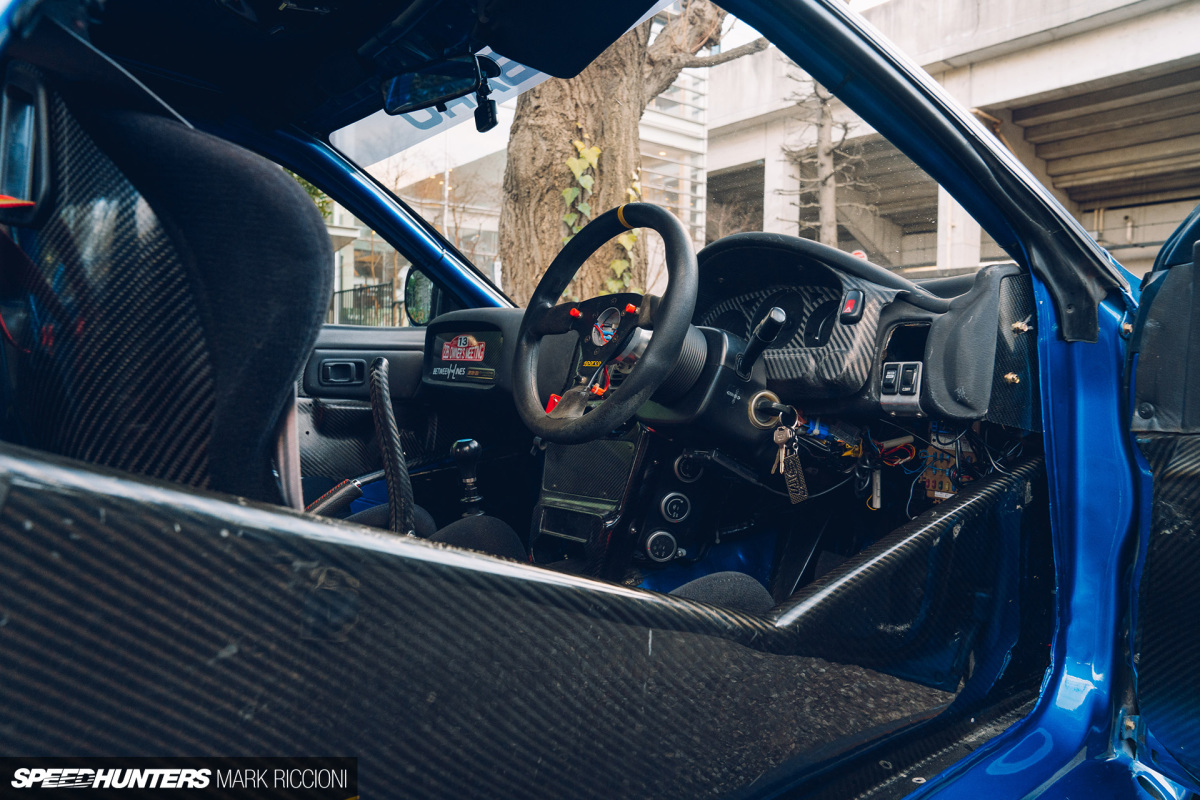As a nation famed for its patience, discipline, and peace of mind, the Japanese seem to have a habit of restoring the most unforgiving and uncompromised race cars to the road.
Probably the most famous – or most documented, at least – is Takeshi Moroi’s Porsche 962C featured by Dino back in 2012. Decades earlier, this would’ve been thundering down the Mulsanne Straight at over 200mph. However, seeing it parked in front of a Tokyo Family Mart is somehow even more impressive.

If you prefer your race cars more suited to anything but smooth tarmac, Junya Matsushita’s S4 Subaru Impreza is the epitome of ’90s WRC. Built by Prodrive for the 1998 season and imported from the Netherlands in 2010, Junya spent years painstakingly restoring it to its former glory. Expensive, but worth every penny.

And for those without the budget to sink into a legitimate ex-racer, all hope is not lost. Simply ditch all your car’s comforts and spend a terrifying amount of time sourcing period-correct parts like wheels and spoilers, and the result is your very own road-going replica. A passion shared by Mashahiko Yamazai and his friends as they rip around the streets of Saitama in their Super Touring-inspired builds.

Race cars will always be cool. That’s a statement every Speedhunter can be united on, and their appeal for being converted from track to road use almost always comes back to the same reason: to create the rawest, most unfiltered and visceral driving experience imaginable… without having to go to the track first.

Is this always enjoyable? Absolutely not. The reality of owning a genuine race car for the road – as opposed to a road car tweaked for the racetrack – can be a lot more painful. And I say that as someone who owned a road-going Ferrari 360 Challenge car for nearly five years, which subsequently spent less than 12 months actually fit for use.

But every now and then, something so unhinged comes along that surprises even the most seasoned Speedhunter, something so obscure and ridiculous it goes beyond the how is it on the road and firmly into the why. Because in the game of road-legal race car Top Trumps, Syuichi Kinoshita has an almost unbeatable hand…


The Lamborghini Diablo wasn’t exactly short of a special edition. Between 1990 and 2001, a total of 2,907 were produced in Sant’Agata, with 18 different versions available over that time. The bulk of those (873) were 2WD Diablos between 1990 and 1996, followed by the VT and VT Roadster (including the later 6.0 in 2000/2001), which between them account for almost two-thirds of Diablos produced.

Delving into the more limited models, the SE30 accounts for just 157 units, followed by the GT with just 81 being built between 1999 and 2000. Then, there are the two racing editions – the SV-R and GTR – limited to 30 units each and exclusively built for racing. Although, according to Instagram, most of these now appear to be road-legal and residing in Japan, too…

However, all of these numbers look positively mass-produced compared to what’s tucked away in Kinoshita-san’s garage. Not only is it one of two REITER Engineering-prepared Diablos built for competition in the GT2 racing class, but it’s also the only one that’s road-legal. And that wasn’t a requirement for competition use or REITER feeling particularly spicy; that’s all on Kinoshita-san who, after obtaining the car in a pretty bad state, decided he might as well throw in the extra bits needed to get it legal for its shaken (roadworthiness) inspection while reassembling it.

“A friend of mine spent nearly three years tracking down and obtaining the car, but once it arrived, the scale of work required was too much for him to handle,” Kinoshita-san explains. “At the time, I already owned a Gallardo LP560, so I understood the appeal and theatre of a Lamborghini. It would take a long time to rebuild and reassemble the REITER GT2 Diablo – around 10 years in total – and these days, the parts are almost impossible to find. And for the parts you can obtain, values have skyrocketed!”

REITER was formed in 2000 by racing engineer Hans Reiter, and the GT2 Lamborghini Diablo would be the first official REITER-prepared car to compete in the FIA GT championship. Taking the already potent Diablo GT as a base, REITER extensively modified both cars to meet the GT2 regulations, with the 6.0-litre V12 engine producing nearly 600hp.

This GT2 Diablo would mark the beginning of REITER’s Lamborghini journey, as for the next 14 years, they’d be responsible for developing and preparing all of Lamborghini’s race editions, including the Gallardo GT3 and the brutal Murciélago R-GT.

“I have always loved cars from a young age, and as soon as I could drive, I would enjoy modifying whatever I owned to make it feel more like a race car on the street,” Kinoshita-san recalls. “At first, I started with an EP71 Starlet, then a JZX90 Mark II and even a GX71 Cresta. I bought my first Lamborghini – the Gallardo LP560 – later on because I loved how rough, powerful and attractive it seemed. It had the looks and performance of a racing car, but it was still very easy to use on the street. Quickly, I became obsessed with all things Lamborghini, and when the opportunity came to buy the REITER GT2, I could not say no.”

With only two cars in existence, the main issue Kinoshita-san faced was trying to replace any missing or damaged components – many of which required custom-making and took months to arrive. Thankfully, the 6.0-litre V12 and Holinger sequential gearbox were still in good condition, and despite its racing history, the all-carbon exterior was complete, including the GT2-specific components such as the diffuser, rear adjustable wing and front splitter. Kinoshita-san knew early on that he wanted to get the GT2 road-ready, so during this process, he took several measures to try and make it a little easier to maintain in the future.


“In racing form, there are no exhaust restrictors, so it is crazy loud!” he adds. “I installed several silencers and an exhaust valve to keep the Diablo quiet at low speed, which I think my neighbours were very happy about. For racing, the fuel tanks are a bag in a Kevlar case, but these expire every few years and are very expensive to replace. So, we created an aluminium tank instead, and at the same time added a front nose-lift system; otherwise, it would be too low to drive into most gas stations.”

“The one thing I would still like to change is the steering rack because trying to get around Japan’s tight roads takes many attempts, but it is a small price to pay to get to use such a crazy car on the road.”

Watching Kinoshita-san thread the Diablo through Tokyo is nothing short of jaw-dropping. Other than the heat – which Kinoshita-san has tried to combat with a token 12V fan in the footwell – it’s surprisingly well-mannered and unusually quiet. Until the exhaust valve flicks open…

The smallest amount of throttle will easily light up the 310-wide Michelins. Don’t be fooled by the grooves; these aren’t typical Pilot Sports or Cup 2s; they’re a full wet-weather competition slick instead. But with indicators, number plates and the ability to crawl over speed bumps, it is fit for the road… just about. And Kinoshita-san doesn’t hide it away either; he’ll regularly join Lamborghini owner days at any opportunity. While its lack of track use might seem like a waste, before he took on the project, it was just another ex-race car in a thousand pieces unfit for any use.

“In addition to the Diablo GT2, I replaced my Gallardo with an Aventador, which is a completely different experience,” adds Kinoshito-san. “The combination of the Lamborghini look and a naturally aspirated V12 is something I think many of us dream of. They are two completely different cars, but they also share a lot of the same DNA, which I think can be found in all Lamborghinis, new and old. But what I would like to do more than anything in 2025 is to take the GT2 back on the racing track to see how it performs. It may not be as fast as modern race cars, but I don’t think there are many other cars out there which will provide the same kind of feeling – and that feeling I will never get bored of.”

You’d think that after a road-legal 926C, a WRC Impreza and a GT2 Diablo, the streets of Tokyo couldn’t get more outrageous. But Kinoshito-san is already eyeing up the next REITER project – a Murciélago R-GT. When it comes to Japan, you never rule anything out.
Mark Riccioni
Instagram: mark_scenemedia
Twitter: markriccioni
mark@speedhunters.com





















